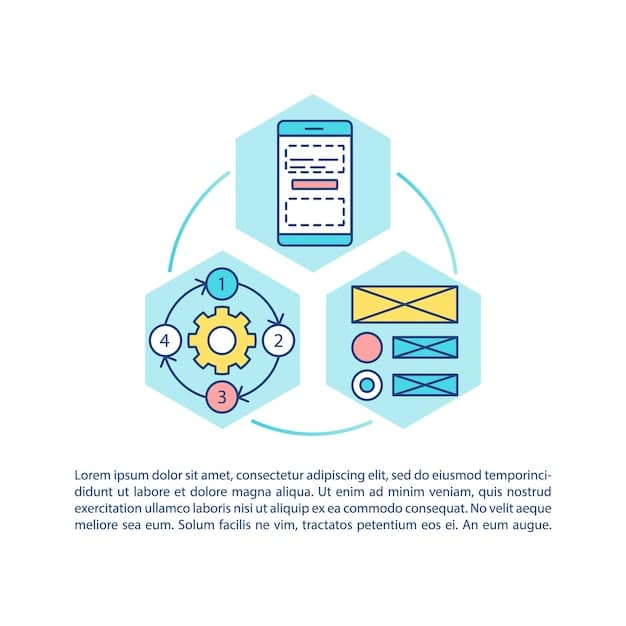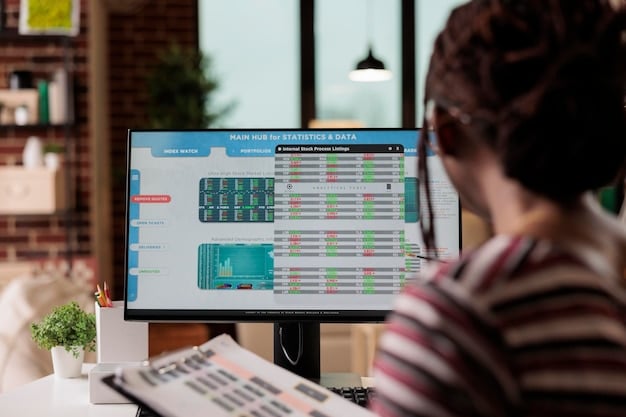Maximize Your Roth IRA: A Step-by-Step Guide to Mega Backdoor Conversions in 2025

A mega backdoor Roth IRA conversion allows high-income earners to contribute significantly more than the standard annual Roth IRA limits, leveraging after-tax contributions to a 401(k) and then converting them to a Roth account, providing tax-free growth and withdrawals in retirement.
Are you looking for ways to supercharge your retirement savings, especially if you’re a high-income earner? The Mega Backdoor Roth IRA Conversion in 2025 offers a powerful, albeit complex, strategy to contribute far beyond traditional Roth IRA limits. This guide will demystify the process, helping you understand how to leverage this advanced financial tactic for a more robust, tax-free retirement.
Understanding the Roth IRA Landscape and How it Evolves
The Roth IRA has long been a favorite tool for retirement savers seeking tax-free growth and withdrawals in retirement. Its appeal is undeniable: contribute after-tax dollars, let your investments grow, and withdraw everything tax-free once you meet the conditions. However, a significant limitation for many high-income earners has been the annual contribution limits and income phase-outs, which can restrict or entirely prevent direct contributions.
As we look towards 2025, the principles of the Roth IRA remain steadfast, but the financial landscape is always subtly shifting. Staying abreast of potential legislative changes, even minor ones, that could impact retirement accounts is crucial. While the core mechanics of a Roth IRA are unlikely to undergo radical overhaul, even slight adjustments to contribution limits or income thresholds can influence planning strategies.
The Appeal of the Roth IRA
For those building a robust retirement portfolio, the Roth IRA stands out due to its unique tax advantages. Unlike traditional IRAs, where contributions might be tax-deductible and withdrawals are taxed in retirement, Roth contributions are made with after-tax dollars. This means that all qualified withdrawals in retirement are completely tax-free, including earnings. This feature is particularly attractive for individuals who anticipate being in a higher tax bracket in retirement than they are today.
- Tax-Free Growth: Investments within a Roth IRA grow tax-free.
- Tax-Free Withdrawals: Qualified distributions in retirement are not taxed.
- No Required Minimum Distributions (RMDs): Unlike traditional IRAs, Roth IRAs do not have RMDs for the original owner, offering greater flexibility.
- Estate Planning Benefits: Roth IRAs can be powerful tools for legacy planning, passing on tax-free assets to beneficiaries.
Navigating the Roth IRA landscape requires a clear understanding of its benefits, its limitations for high earners, and the evolving strategies, such as the mega backdoor conversion, that allow more individuals to access its advantages. As regulations and personal financial situations change, adapting your approach becomes key to maximizing your retirement savings potential.
The traditional Roth IRA offers a compelling path to tax-free retirement income, making it a cornerstone for many financial plans. Its structure is particularly beneficial for younger individuals who have a long investment horizon, allowing their contributions and earnings substantially more time to compound tax-free. For those closer to retirement, it still provides valuable diversification in tax treatment of retirement funds.
What is a Mega Backdoor Roth Conversion?
The term “mega backdoor Roth” might sound complex, but at its core, it’s a strategic way to bypass traditional Roth IRA income and contribution limits. It leverages specific features of employer-sponsored 401(k) plans to move a significant sum of money into a Roth account, far exceeding the standard annual Roth IRA contribution limits. This strategy is distinct from a “backdoor Roth,” which typically involves contributing to a non-deductible traditional IRA and then converting it to a Roth, primarily for those whose income exceeds Roth IRA direct contribution limits.
In simple terms, a mega backdoor Roth involves making after-tax contributions to your 401(k), and then converting those after-tax funds into a Roth IRA. This is possible because the IRS allows 401(k) plans to accept after-tax contributions beyond the standard pre-tax and Roth 401(k) limits. The combined limit for all 401(k) contributions (employee deferrals, employer contributions, and after-tax contributions) is quite high, providing a substantial window for this strategy.
Key Components of the Mega Backdoor Roth
- After-Tax 401(k) Contributions: Your employer’s 401(k) plan must permit voluntary after-tax contributions. This is a critical requirement, as not all plans offer this feature. These contributions are made with money that has already been taxed, meaning you won’t owe taxes on that principal when you convert it.
- In-Service Withdrawal or Rollover: Once you’ve made after-tax contributions, the plan must allow you to perform an “in-service withdrawal” or “in-service non-hardship distribution.” This means you can move funds out of your 401(k) while still employed.
- Conversion to a Roth IRA: The withdrawn after-tax funds are then rolled over or converted into your Roth IRA. Any earnings on these after-tax contributions within the 401(k) before the conversion will be taxable upon conversion, so it’s often advisable to convert as quickly as possible to minimize these taxable earnings.
This strategy is particularly appealing because it allows individuals whose income is too high for direct Roth IRA contributions, or those who simply wish to contribute more than the standard limits, to still benefit from the tax-free growth and withdrawals of a Roth account in retirement. It’s a method for high earners to maximize their Roth savings, offering a significant advantage over time.
It’s vital to remember that while powerful, the mega backdoor Roth conversion requires careful adherence to IRS rules and a thorough understanding of your employer’s 401(k) plan. Not all plans are structured to facilitate this strategy, so checking with your plan administrator is the indispensable first step. Planning and execution must be precise to avoid unintended tax consequences.
Eligibility Requirements for 2025

While the mega backdoor Roth conversion offers an attractive pathway to boost your tax-free retirement savings, it’s not universally accessible. Several key eligibility requirements must be met, primarily revolving around your employer’s 401(k) plan and your financial capacity. For 2025, these foundational requirements are expected to remain consistent with previous years, though it’s always prudent to monitor any potential legislative changes.
The primary hurdle is often your employer’s 401(k) plan. It must be structured to specifically allow for two crucial components that are non-negotiable for this strategy to work. Without these, the mega backdoor Roth conversion simply isn’t an option through your current employer’s plan.
Employer 401(k) Plan Must Allow:
- After-Tax Contributions: Your 401(k) plan must permit voluntary after-tax contributions. This is distinct from Roth 401(k) contributions (which are also after-tax, but have different contribution limits) and traditional pre-tax contributions. Many plans do not offer this option, making it the first and most significant barrier.
- In-Service Non-Hardship Withdrawals/Distributions: The plan must allow you to take money out while you are still employed and before retirement age, specifically for non-hardship reasons. This is often referred to as an “in-service distribution” or “in-service rollover.” Without this, your after-tax contributions would be locked in your 401(k) until you leave your employer or retire, negating the purpose of converting them to a Roth IRA.
Beyond these plan-specific requirements, your individual financial situation plays a significant role. To effectively utilize the mega backdoor Roth, you need sufficient disposable income to make substantial after-tax contributions to your 401(k). Remember, these contributions come from your net pay, after all other deductions.
It’s important to differentiate after-tax 401(k) contributions from Roth 401(k) contributions. Both are made with after-tax money, but Roth 401(k) contributions are part of your elective deferral limit (e.g., $23,000 in 2024, likely similar in 2025), whereas after-tax 401(k) contributions fall under the much higher overall 401(k) contribution limit. For 2024, the total 401(k) contribution limit (employee + employer + after-tax) was $69,000 ($76,500 for those 50 and over), which is expected to increase for 2025. This higher limit is what makes the mega backdoor strategy so powerful.
Before proceeding, always consult with your employer’s HR department or 401(k) plan administrator to confirm these specific features are available in your plan. Their confirmation is essential. Additionally, consider speaking with a financial advisor to understand the full implications for your personal tax situation, as tax rules can be intricate and specific circumstances can alter desired outcomes.
Step-by-Step Guide to Mega Backdoor Conversions in 2025
Executing a mega backdoor Roth conversion requires precision and adherence to a defined sequence of steps. While the underlying principles remain constant, staying organized and informed about your plan’s specifics is key to a successful conversion in 2025. Here’s a detailed breakdown of the process.
Before embarking on this journey, ensure you’ve confirmed your employer’s 401(k) plan allows both after-tax contributions and in-service distributions. Without these, the rest of the steps are moot. This confirmation is the absolute prerequisite to proceeding.
Step 1: Maximize Your Standard 401(k) Contributions
The first step is to maximize your annual pre-tax or Roth 401(k) contributions (employee deferrals). For 2025, this limit will likely be around $23,500-$24,000, plus an additional catch-up contribution for those aged 50 and over. You cannot make after-tax contributions until you have hit your elective deferral limit. This ensures you’re taking full advantage of your primary 401(k) savings opportunities first.
Step 2: Make After-Tax Contributions to Your 401(k)
Once your standard 401(k) contributions are maxed out, you can begin making voluntary after-tax contributions to your 401(k). This is where the “mega” aspect comes into play. The total amount you can contribute to your 401(k) in a given year (including your pre-tax/Roth 401(k) contributions, employer contributions, and your after-tax contributions) is capped at a much higher limit – estimated to be around $70,000-$72,000 for 2025 ($77,000-$79,000 if you’re 50 or older and make the catch-up). Deduct your standard contributions and employer contributions from this total limit to determine how much you can contribute after-tax.
- Set up deductions: Work with your payroll or HR department to set up after-tax contributions.
- Monitor limits: Keep a close eye on your total contributions to avoid exceeding the annual IRS limits.
Step 3: Initiate an In-Service Rollover/Withdrawal
After your after-tax contributions have been made (and preferably as soon as possible to minimize earnings on the after-tax money), initiate an in-service rollover or withdrawal from your 401(k) plan. Contact your 401(k) administrator to request this. You’ll typically have two options for the distribution:
- Direct Rollover to a Roth IRA: The administrator can send the after-tax funds directly to your Roth IRA account. This is the simplest and preferred method.
-
Check Payable to You (for Rollover to a Roth IRA): The administrator can send you a check for the after-tax funds. You then have 60 days to deposit this into your Roth IRA. Be very careful with this option to avoid missing the 60-day window and incurring taxes/penalties.
Step 4: Convert to a Roth IRA
When the after-tax funds are received (either directly or via check), ensure they are deposited into your Roth IRA. If there were any earnings on your after-tax contributions while they were in the 401(k), these earnings will be taxable income in the year of the conversion. This is why converting quickly is often recommended, as it minimizes the potential for taxable earnings.
It’s essential to understand that this conversion is reported to the IRS. You’ll receive a Form 1099-R from your 401(k) administrator detailing the distribution, and you’ll need to accurately report it on your tax return. Maintaining meticulous records is paramount.
By following these steps, you can effectively leverage the mega backdoor Roth strategy to funnel significant sums into a tax-free retirement account. The process demands attention to detail and a clear understanding of your specific plan’s rules, but the long-term tax benefits can be substantial.
Pros and Cons of Mega Backdoor Roth Conversions
Like any advanced financial strategy, the mega backdoor Roth conversion comes with its own set of advantages and disadvantages. Understanding both sides of the coin is crucial for determining if this tactic aligns with your financial goals and risk tolerance. While the benefits are compelling for many high-income individuals, the complexities and potential drawbacks warrant careful consideration.
The decision to pursue a mega backdoor Roth should not be taken lightly. It requires a deep dive into your current financial situation, future income projections, and an assessment of your comfort level with managing nuanced tax implications.
Advantages:
- Significant Tax-Free Growth: This is the primary draw. By moving substantial after-tax funds into a Roth IRA, you gain the benefit of tax-free growth and tax-free withdrawals in retirement, potentially saving you tens or even hundreds of thousands of dollars in taxes over the long term. This is especially valuable if you expect to be in a higher tax bracket in retirement.
- Bypass Income Limits: The mega backdoor Roth allows high-income earners who are otherwise phased out of direct Roth IRA contributions to still access Roth benefits. It provides a legal workaround to contribute beyond the standard limits.
- No Required Minimum Distributions (RMDs) for Original Owner: Funds held in a Roth IRA are not subject to RMDs during the original owner’s lifetime. This offers greater flexibility in managing your retirement income and can be beneficial for estate planning, allowing the funds to continue growing tax-free for beneficiaries.
- Tax Diversification: A mega backdoor Roth can diversify your retirement income sources. Having both pre-tax (401(k), Traditional IRA) and after-tax (Roth IRA) accounts provides flexibility in retirement to withdraw from whichever account is most advantageous given your tax bracket at the time.
Disadvantages:
- Complexity: The strategy involves multiple steps, specific employer 401(k) plan features, and careful adherence to IRS rules. It can be confusing to implement without professional guidance.
- Requires Specific 401(k) Plan Features: As discussed, your employer’s 401(k) plan must allow both after-tax contributions and in-service distributions. Many plans do not.
- Potential for Taxable Earnings: If there’s a delay between making after-tax contributions to your 401(k) and performing the conversion to a Roth IRA, any earnings on those after-tax funds will be taxable upon conversion. While usually minimal if done quickly, it’s a consideration.
- Pro-Rata Rule for Other IRAs: If you have existing pre-tax traditional IRA balances (from rollovers of old 401(k)s, for example), the “pro-rata” rule could kick in. This rule dictates that any Roth conversion (including from a 401(k) or traditional IRA) must be prorated across all your traditional IRA accounts (pre-tax and non-deductible). This can lead to a portion of your conversion becoming taxable, offsetting some of the benefits. This is a crucial point for those with existing traditional IRA balances.
- Not for Everyone: This strategy is primarily for high-income earners who have already maxed out other tax-advantaged accounts and still have additional savings capacity. It doesn’t replace the need for an emergency fund or other financial priorities.
Weighing these pros and cons carefully against your personal financial situation and goals is paramount. For many, the benefits of significant tax-free growth outweigh the complexities, but it’s essential to proceed with full awareness of the requirements and potential pitfalls.
Tax Implications and Reporting for 2025
Navigating the tax implications of a mega backdoor Roth conversion is perhaps the most critical aspect of the strategy. While the overarching goal is tax-free growth, the conversion process itself has specific tax reporting requirements that, if misunderstood, can lead to unexpected tax liabilities. For 2025, taxpayers should anticipate that these rules will largely remain consistent.
Understanding what gets taxed, what doesn’t, and how to properly report it to the IRS is fundamental to the success of this strategy. Errors in reporting can negate the very benefits you are seeking.
What is Taxable?
The primary consideration for taxation during a mega backdoor Roth conversion are the “earnings” on your after-tax 401(k) contributions. The principal (your original after-tax contributions) is not taxed upon conversion because it was already taxed when you earned it. However, if any investments grow within your 401(k) after you make an after-tax contribution and before you convert it to a Roth IRA, those investment gains are considered pre-tax earnings. When these earnings are converted to a Roth IRA, they become taxable income in the year of conversion.
- After-Tax Contributions: Not taxable upon conversion.
- Earnings on Contributions: Taxable upon conversion, as ordinary income.
To minimize these taxable earnings, it is generally advised to execute the in-service distribution and conversion as quickly as possible after making the after-tax contributions. This reduces the time for potential investment growth within the 401(k).
The Pro-Rata Rule: A Critical Consideration
One of the most complex tax implications, especially for those who already have existing traditional IRA balances, is the “Pro-Rata Rule.” This rule comes into play when you convert funds from a traditional IRA to a Roth IRA. While a mega backdoor Roth conversion originates from a 401(k), if any portion of your after-tax 401(k) withdrawal is rolled into a Traditional IRA first (perhaps inadvertently) and then converted, or if you also conduct a “regular” backdoor Roth conversion, the pro-rata rule can impact your entire Roth conversion strategy.
The IRS treats all your non-Roth IRA accounts (Traditional, SEP, SIMPLE IRAs) as one for the purpose of Roth conversions. If you have both pre-tax and after-tax (non-deductible) money across these accounts, any conversion from a traditional IRA to a Roth IRA will be taxed proportionally, based on the percentage of pre-tax funds in your aggregated IRA balance. This can lead to a portion of seemingly after-tax money being taxed upon conversion if you have commingled pre-tax and after-tax funds in IRAs. It often necessitates a “reverse rollover” of pre-tax IRA funds into an employer 401(k) that accepts rollovers, to clear out the pre-tax IRA balance before executing conversions. This is a highly nuanced area where professional tax advice is often invaluable.
Reporting to the IRS
You will receive a Form 1099-R from your 401(k) plan administrator reporting the distribution from your 401(k). This form will indicate the total amount distributed and the taxable portion (if any). You will then need to accurately report this conversion on your Form 8606, “Nondeductible IRAs,” when you file your income tax return. Form 8606 tracks your non-deductible IRA contributions and conversions, ensuring that the after-tax principal is not taxed again upon withdrawal in retirement.
It’s advisable to consult with a qualified tax professional before and after performing a mega backdoor Roth conversion. They can help you understand the specific implications for your situation, ensure proper reporting, and help you navigate the pro-rata rule if it applies to you. Missteps in reporting can lead to unnecessary taxes and penalties.
Is a Mega Backdoor Roth Conversion Right for You?
Deciding whether a mega backdoor Roth conversion is the right financial move requires a thorough assessment of your personal circumstances, future financial goals, and comfort level with financial complexity. It’s a powerful strategy, but it’s not suitable for everyone. While the allure of tax-free growth is strong, it’s essential to consider if you meet the practical and financial prerequisites, and if it aligns with your broader financial plan for 2025 and beyond.
This strategy is typically most impactful for a very specific financial profile. Before diving in, ask yourself these crucial questions to determine its suitability for your situation.
Key Factors to Consider:
- High Income Earner: Are you consistently maxing out your other retirement accounts (401(k), traditional IRA/Roth IRA if eligible) and seeking additional ways to save for retirement on a tax-advantaged basis? The mega backdoor Roth is designed for those who have exhausted standard contribution limits due to high income or a desire to save significantly more.
- Access to a Compatible 401(k) Plan: Does your employer’s 401(k) plan permit both voluntary after-tax contributions and in-service distributions? This is a non-negotiable requirement. If your plan doesn’t offer these features, the mega backdoor Roth through your employer’s plan isn’t an option.
- Sufficient Disposable Income: Do you have extra cash flow after meeting all your other financial obligations (emergency fund, debt repayment, mortgage, etc.) to make substantial after-tax contributions? These contributions can be tens of thousands of dollars, so ensure you have the financial capacity without compromising other financial priorities.
- Long Time Horizon: The benefits of tax-free growth compound significantly over time. While beneficial at any age, the strategy is particularly powerful for those who have many years until retirement, allowing investments ample time to grow.
- Comfort with Complexity: Are you comfortable managing the intricacies of this strategy, including understanding the tax implications, reporting requirements, and potentially navigating the pro-rata rule if you have existing traditional IRA balances? While financial advisors can help, a basic understanding (or willingness to learn) is beneficial.
- Future Tax Bracket Expectations: Do you anticipate being in a higher tax bracket in retirement than you are today? If so, the tax-free withdrawals of a Roth account become even more valuable, making the mega backdoor Roth a compelling strategy. If you expect to be in a lower tax bracket, pre-tax contributions to a traditional 401(k) or IRA might be more advantageous.
It’s important to view the mega backdoor Roth as an advanced strategy for enhancing retirement savings, not as a shortcut or a first step in saving. It complements, rather than replaces, traditional retirement planning. For those who meet the criteria, it offers an exceptional opportunity to build a substantial pool of tax-free wealth.
If you’re unsure about any of these points, or if your financial situation is complex, consulting with a fee-only financial advisor and a tax professional is highly recommended. They can provide personalized advice, review your specific plan details, and help you determine if this strategy aligns with your overall financial picture.
Future Outlook and Planning for 2025 and Beyond
As we look to 2025 and the years beyond, the landscape of retirement planning, while generally stable, is always subject to potential shifts. While radical changes to the mega backdoor Roth strategy are not widely anticipated, legislative adjustments, economic conditions, and evolving personal financial situations necessitate ongoing vigilance. Proactive planning is key to maximizing the effectiveness of this powerful tool for long-term wealth accumulation.
The core mechanics of the mega backdoor Roth conversion are rooted in the Internal Revenue Code, which typically sees only incremental adjustments. However, even small changes to contribution limits, income thresholds, or regulatory interpretations can ripple through financial strategies.
Staying Informed on Potential Changes
Tax laws, while aimed at long-term stability, are responsive to economic and social pressures. It is always wise to keep an eye on financial news and legislative developments that could impact retirement accounts. For instance, while the “Secure Act 2.0” primarily focused on enhancing retirement savings, future legislation could potentially introduce new complexities or limitations. Staying subscribed to reputable financial news sources or working with a knowledgeable financial advisor can help you remain informed.
- IRS Announcements: The IRS typically announces new contribution limits and other relevant figures late in the year for the upcoming year. Keep an eye on these announcements for 2025 limits.
- Legislative Updates: Congressional discussions around tax reform or retirement account changes can signal potential future impacts. While difficult to predict, being aware of discussions is helpful.
Optimizing Your Strategy Annually
The mega backdoor Roth is not a one-time setup; it’s an annual opportunity. Each year, you’ll need to reassess your ability to make after-tax contributions, considering your income, expenses, and other financial goals. Review your employer’s 401(k) plan for any changes, especially if they switch providers or introduce new policies.
Furthermore, evaluating your investment strategy within the Roth IRA is crucial. Since the earnings will be tax-free, this is an excellent account for highly appreciating assets. Consider the long-term growth potential of your investments within your Roth IRA, aligning them with your overall risk tolerance and retirement timeline.
The Importance of Professional Guidance
Given the complexity of the mega backdoor Roth and its interplay with overall tax and financial planning, seeking professional guidance remains invaluable. A qualified financial advisor can help you:
- Confirm your eligibility and the specifics of your employer’s plan.
- Optimize the annual contribution amounts and timing of conversions.
- Navigate the pro-rata rule if it applies to your situation.
- Integrate the mega backdoor Roth into your broader financial plan, including estate planning and overall tax efficiency.
Looking ahead to 2025 and beyond, the mega backdoor Roth conversion stands as a robust strategy for high-income earners aiming to maximize their tax-free retirement savings. By staying informed, planning meticulously, and leveraging expert advice, you can position yourself to fully capitalize on this powerful financial tool, securing a more comfortable and tax-efficient retirement.
| Key Point | Brief Description |
|---|---|
| 🚀 Eligibility Check | Your 401(k) must allow after-tax contributions and in-service distributions. |
| 📈 Maximize First | Always max out standard 401(k) contributions before after-tax. |
| 💡 Convert Quickly | Convert after-tax funds to Roth IRA swiftly to minimize taxable earnings. |
| ⚖️ Mind Pro-Rata | Be aware of the pro-rata rule if you have existing traditional IRA balances. |
Frequently Asked Questions About Mega Backdoor Roth Conversions
▼
A “backdoor Roth” helps high-income earners contribute to a Roth IRA when direct contributions are phased out, by converting non-deductible Traditional IRA contributions. A “mega backdoor Roth” leverages after-tax 401(k) contributions and converts them to a Roth IRA, allowing much higher contribution amounts beyond standard IRA limits.
▼
You can perform a mega backdoor Roth conversion as often as your 401(k) plan allows you to make after-tax contributions and subsequent in-service distributions. Many people do this annually, or even multiple times throughout the year, to steadily move after-tax funds into their Roth IRA.
▼
No, there are no specific income limits that prevent you from performing a mega backdoor Roth conversion. Its primary utility is precisely for high-income earners who exceed the income limits for direct Roth IRA contributions, providing a workaround to still contribute substantial amounts to a Roth account.
▼
If your employer’s 401(k) plan does not permit both after-tax contributions and in-service non-hardship withdrawals, then the mega backdoor Roth strategy is not available to you through that specific plan. You would need to explore other retirement savings strategies or advocate for your plan to offer these features.
▼
If you have existing pre-tax money in Traditional, SEP, or SIMPLE IRAs, the IRS’s “pro-rata” rule will apply to any Roth conversion. This means a portion of your conversion would be taxable, even if it originated from after-tax funds, potentially complicating the strategy and reducing its tax efficiency.

Conclusion
The mega backdoor Roth conversion stands as a sophisticated yet incredibly powerful strategy for high-income earners to maximize their tax-free retirement savings. By meticulously navigating the steps of making after-tax 401(k) contributions and subsequently converting them to a Roth IRA, individuals can bypass standard income and contribution limits, unlocking a significant avenue for tax-free growth and withdrawals in retirement. While the process demands careful attention to eligibility requirements, tax implications, and plan-specific rules, the long-term benefits of a sizable Roth account can be transformative for a secure financial future. For those with the income and access to a compatible 401(k) plan, mastering this strategy in 2025 offers a compelling path toward an even more robust retirement nest egg.





